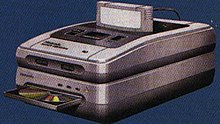Super NES CD-ROM
 SNES-CD add-on prototype | |
| Manufacturer | Nintendo/Sony |
|---|---|
| Type | Video game accessory, video game console |
| Generation | Fourth generation |
| Release date | Unreleased |
| Media | CD-ROM, ROM cartridges |
SNES-CD refers to an unreleased video game media format and peripheral for the Super Nintendo Entertainment System (SNES). The device and the format were to build upon the functionality of the cartridge-based SNES by adding support for higher capacity compact discs.
Development of the format started in 1988, when Nintendo signed a deal with Sony to produce a CD-ROM add-on for the SNES. After several years of development, Sony introduced a standalone console at 1991's summer Consumer Electronics Show called the "Play Station." The system was to be compatible with existing SNES titles as well as titles released for the SNES-CD format. However, due to licensing disagreements with Sony, Nintendo announced that it had formed an alliance with Sony's rival Philips to produce the SNES-CD add-on.[1][2]
The partnership with Philips did not produce a CD add-on for the SNES. Eventually Sony dropped its partnership with Nintendo and developed its own console independently, which resulted in the release of the original PlayStation, a chief competitor of the SNES's cartridge-based successor, the Nintendo 64.
Development
The Sony/Nintendo relationship started when Sony engineer Ken Kutaragi became interested in working with video games after seeing his daughter play games on Nintendo's Famicom video game console. He took on a contract at Sony for developing hardware that would drive the audio subsystem of Nintendo's next console, the Super NES. Kutaragi secretly developed the chip, known as the Sony SPC 700. As Sony was uninterested in the video game business, most of his superiors did not approve of the project, but Kutaragi found support in Sony executive Norio Ohga and the project was allowed to continue. The success of the project spurred Nintendo to enter into a partnership with Sony to develop both a CD-ROM add-on for the Super NES and a Sony-branded console that would play both SNES games, as well as titles released for the new SNES-CD format.[3]
However, the two companies conflicted over control of the licensing. Under their agreement, Sony would develop and retain control over the SNES-CD disc format, Nintendo thus effectively ceding a large amount of control over software licensing to Sony. To counter this, Nintendo president Hiroshi Yamauchi sent Nintendo of America president Minoru Arakawa and executive Howard Lincoln to Europe to negotiate a more favorable deal with Philips, Sony's industry rival. At the June 1991 Consumer Electronics Show, Sony announced its SNES-compatible cartridge/CD console, the "Play Station". The next day, Nintendo revealed its partnership with Philips via a surprise announcement at the show.[2]
About 200 prototypes of the Play Station had been created and software for the system was being developed as Nintendo and Sony attempted to sort out their differences. In 1992, a deal was reached allowing Sony to produce SNES-compatible hardware, with Nintendo retaining control and profit over the games, but the two organizations never repaired the rift between them. By the next year, Sony had refocused its efforts on developing its own console for the next generation of consoles.[3][4]
Legacy
After the original deal with Sony fell through, Nintendo continued its partnership with Philips. The deal produced a few games featuring Nintendo characters for Philips's CD-i multimedia device, but never resulted in a CD-ROM add-on for the SNES.[4] The CD-i itself was pegged as a commercial failure.[5]
Ken Kutaragi and Sony continued to develop their own console and released the PlayStation in 1994. The CD-based console successfully competed with Nintendo's cartridge-based Nintendo 64. The broken partnership with Sony has been cited as an error on Nintendo's part, effectively creating a formidable rival in the video game market.[6][3] Nintendo would not release an optical disc based console until the release of the GameCube in 2001.[4]
According to a recent video, it is believed Ólafur Jóhann Ólafsson, former CEO of Sony Interactive Entertainment, Inc. kept a prototype of the Nintendo Playstation. According to the story, he brought this early model with him when he left Sony for Advanta Corporation. It was kept in a box that was meant to be thrown out. This unit was supposedly found by the worker's son, but this story is yet to be confirmed.[7]
See also
- Sega CD, the equivalent CD-ROM add-on unit released for the rival Sega Mega Drive/Genesis
- TurboGrafx-CD, the CD-ROM add-on unit for the TurboGrafx-16, and the first attachment for playing CD-based games released for a dedicated game console
- Nintendo 64DD, magnetic disc add-on released for the Nintendo 64
- Pioneer LaserActive, disc-based system compatible with the Sega Mega Drive/Genesis and TurboGrafx-16 through add-on units
References
- ^ Edge staff (24 April 2009). "The Making Of: PlayStation". Edge. Future Publishing. Retrieved 7 March 2012.
- ^ a b IGN staff (27 August 1998). "History of the PlayStation". IGN. Retrieved 8 March 2012.
- ^ a b c Fahey, Rob (27 April 2007). "Farewell, Father". Eurogamer.net. Retrieved 8 March 2012.
- ^ a b c Cowan, Danny (2006-04-25). "CDi: The Ugly Duckling". 1UP.com. Retrieved 8 March 2012.
- ^ Blake Snow (2007-05-04). "The 10 Worst-Selling Consoles of All Time". GamePro.com. Archived from the original on 2007-05-08. Retrieved 2007-11-25.
- ^ Nutt, Christian. "Birthday Memories: Sony PlayStation Turns 15". Gamasutra. Retrieved 8 March 2012.
- ^ Brian Crecente (2015-07-03). "HOW MISFORTUNE AND A BIT OF LUCK LED TO THE DISCOVERY OF THE FABLED NINTENDO PLAY STATION". Polygon.com. Retrieved 2015-07-07.
{{cite web}}: Cite has empty unknown parameter:|1=(help)
